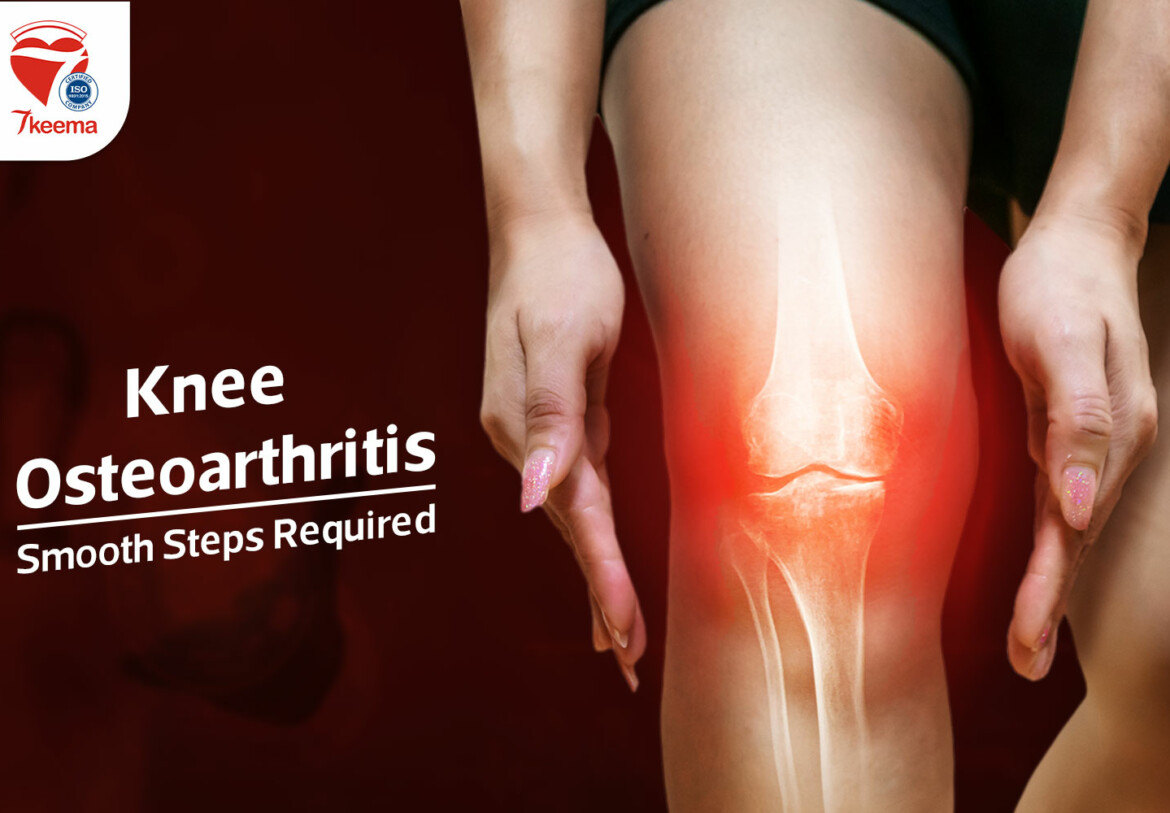Bones are connected through joints, which are meant to work, move, and interact smoothly and in harmony—though friction is produced along with our daily movements and motions, yet appropriately absorbed by a layer that lies between bones called cartilage. Talking about the body’s joints, knees are the most to be mentioned, as they are the primary support of the whole body.
On the other side, when these cartilages between knees bones are infected in any way, we got a problem. This is called Knee Osteoarthritis, which takes part in arthritis that could be more likely to occur during the geriatric phase.
It’s widely known that knee osteoarthritis leads to many symptoms and signs that could prevent from having an everyday daily life. Out of what, we dedicated this article to discuss the whole aspects of knee osteoarthritis, symptoms, causes, and treatment.
What’s Knee Osteoarthritis?
It’s one specific kind of osteoarthritis, the leading cause of arthritis all around the body. Alternatively, knees may be more subjected to such cases because they hold almost all the body weight, not to mention their involvement through every single movement.
Movement leads to friction inside body joints between bones, which are typically absorbed and contained by cartilage layers. Knee osteoarthritis is when this layer is subjected to erosion or fractures, leading to more rough movement and knees pain in general.
As well, the lining membrane inside the joint is subjected to inflammations; this membrane secretes many fluids into the joints, making movement less rough and smoother. In this case, these fluids would accumulate on the knee, causing swelling, it is one of the most common symptoms of inflammation
In fact, treatment is provided according to many factors, including symptoms severity and how bad the cartilage is actually damaged. A doctor would recommend drug therapy with physiotherapy sessions in parallel, while surgical intervention is on the table according to the doctor’s judgement.
Out of knee osteoarthritis many causes and ways of treatment, we dedicated this article to spread out all that matter, discussing the case covering all its aspects.
Knee Osteoarthritis Causes
In fact, knee osteoarthritis is due to many causes, varying between one and another, for it can’t be just concluded into ageing and geriatric signs.
It’s most likely to have Knee osteoarthritis due to one of these following causes:
– Age: no doubt, it’s one of the main reasons leading to such a case, as the knee’s cartilages get more fragile and weaker over time, in addition to many habits that could increase the cartilage erosion rate. In general, overcoming 45 is considered the beginning of knee roughness
– Genetic factors: many scientists and studies have proved its connection to heritable reasons, believing it could be transmitted between generations. It’s more likely to have knee osteoarthritis if someone in the family has had it before.
– Gender: statistically, knee osteoarthritis patients are more likely to be females than males, especially for those who are over the age of 50.
– Rheumatic diseases: increasing the risk of knee osteoarthritis in an obvious way.
– Repetitive stress: due to daily activities and wrong techniques while holding any heavyweights, knee osteoarthritis is more likely to occur. These activities include stairs climbing and descending, knee bending for long times, sitting in wrong positions, overloading on the knee, and many more acts that would lead to such thing.
– Previous injuries: The risk of knee osteoarthritis increases due to a previous knee injury, such as meniscal tendon rupture.
– Obesity and overweight: the heavier the knee is holding, the more likely it is to have osteoarthritis, from which we can deduce how being overweight or obese can affect the knee’s health.
Obesity & Knee Osteoarthritis Connection
Many studies have shown a strong bond between obesity and knee osteoarthritis, as it’s directly proportional connected with knee osteoarthritis risk.
In fact, it was found that every extra degree of body mass index (BMI) equals 11% more risk of having knee osteoarthritis.
Body mass index (BMI) is calculated by a certain equation, which you can get to know through checking this article.
Knee Osteoarthritis Symptoms
It’s obviously diagnosed by many apparent symptoms, which could vary from one to another due to many factors.
Main knee osteoarthritis symptoms could be mentioned as follows:
– Knee pain increases while moving, especially with walking for long distances and climbing stairs. And it could be developed into constant pain, even during rest and sleeping.
– Knee swelling accompanies the internal lining membrane inflammation, causing fluid accumulation.
– Knee temperature gets higher with a skin colour change.
– Knee stiffness or low stretching range due to knee swelling or the formation of some bony spurs.
– Knee deformation varies according to the knee osteoarthritis severity.
– Crackling sound while moving.
– Bowlegs due to one-sided bone erosion.
Knee Osteoarthritis Degrees:
Knee osteoarthritis symptoms go through many phases, where each one is considered more severe and critical than its previous one.
For instance, knee osteoarthritis symptoms take an upward track of severity if not treated as they should be until it could prevent the patient from having a free movement ability.
Knee osteoarthritis is divided into 4 degrees as follows:
– 1st degree:
Knee starts to develop symptoms, yet, it’s almost not sensible; the patient wouldn’t have a clear sign that there’s something wrong.
Few cases are developing signs throughout this phase, such as feeling some prick into the knee while walking or climbing stairs.
Accordingly, this phase doesn’t require particular treatment, and it only needs some instructions to be followed.
It’s highly recommended to follow these tips:
Daily workouts and exercise significantly strengthen the knee.
Receiving healthy meals rich in essential nutrition elements.
Avoid heavy weights lifting.
Keep a good shape and avoid obesity.
– 2nd degree:
Knee osteoarthritis symptoms start to get more prominent, yet, without preventing the patient from any regular activity or having any serious impact.
The patient would feel some pricks through their knee, get a stiff knee due to long time sitting or too high physical effort such as walking or running, as well this feeling could be sensible in the morning right after waking up.
Typically, when any of these is felt, the patient should head to a specialist doctor to receive the best treatment for his knee according to symptoms severity and degree.
Throughout this phase, many bumps are developed into the knee bones, which’s could be detected by an X-Ray examination, and it’s the clearest sign of the 2nd-degree symptoms.
– 3rd degree:
This phase of osteoarthritis is considered a mid-severity area, as many more symptoms start to take place and profoundly impact patients’ daily lives without being massively disturbing.
Throughout this phase, cartilages erosion is increased in some obvious ways, leading to more friction between knee bones, which reflects another time on erosion rate and causes considerable pain. Meanwhile, pain is barely bearable while practising any kind of laborious physical exercise, not to mention what obesity could provoke.
This phase would require some more efficient treatments, described only by a specialist doctor. Drug therapy would be rolling around pain killers and cartilage erosion compensation. As well, avoiding any hard physical exercise is mandatory, and getting enough amounts of rest is required in order to give the knee a chance to recover from constant friction.
Moreover, physiotherapy could be recommended, as it helps a better and smoother recovery.
From its side, 7keema is providing a physiotherapy service at home, which could be ordered through a mobile application easily.
– 4th degree:
This phase is pretty critical and has a broader impact on daily life routines, where almost every simple and easy motion would be a vast challenge to accomplish.
It’s when friction reaches out directly to knee bones without any protection. Therefore, pain could mount to some unbearable levels during this phase, lose the ability to have an everyday life, and most probably have meniscal tendon rapture.
It’s most likely to need a surgical intervention throughout this phase to replace the whole joint with another artificial one, and a specialist doctor could only decide it according to the patient’s needs and knee osteoarthritis severity.
Out of these degrees, we can conclude that the earlier the knee is treated, the easiest is to avoid complications. Leading us to wonder how knee osteoarthritis could be treated?
Knee Osteoarthritis Treatment
According to the degree, a treatment could be set. Although, we’re going to spread out some of the most common treatments suitable for knee recovery.
Drug therapy:
A doctor would recommend many kinds of drugs and medicines, whether pills or injections, to help out healing and controlling pain. Between which we can mention the following:
– Anti-inflammatories
– Topical analgesics
– Steroid injections
– Glucosamine supplements, which are naturally secreted inside a joint.
Natural Ways To Treat Knee Osteoarthritis:
In general, it only requires some tips to follow in order to control symptoms severity and avoid diving into more profound degrees. In fact, these tips are applicable during the early stages.
These tips could be mentioned as follows:
– Losing any extra weight and avoiding obesity no matter its costs. From its side, obesity is the leading cause of many other diseases such as diabetes, high blood pressure, and high cholesterol.
– Workout and sports activity daily, at least for 30 mins.
– Using warm or cold compresses.
– Massage and physiotherapy.
– Water knee exercise, which makes it easier and more efficient.
– Have enough sleeping nights.
Knee Osteoarthritis Surgical Solution:
When it’s getting more severe and not responding to any of the previous treatments, the doctor would recommend a surgical intervention to help patients reach their normal lives again.
– Laparoscopic surgery: suitable for those under the age of 40.
– Bones removing surgery.
– Replacing the knee joint surgery.
Not to mention the physiotherapy solution afterwards and following a healthy lifestyle.








